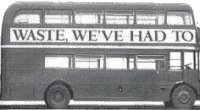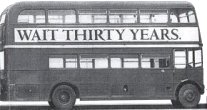
The text below is an advertisement by British Nuclear Fuels (managing waste at Sellafield).
I found it some time ago in The Sunday Times.
I am sure that this ad can be discussed quite controversial.
 |
 |
Are you surprised at how little high level nuclear waste has been produced?
A lot of people are.
There seems to be a general feeling that acres and acres of it are lying around, barely
secured, with a radioactive life of thousands of years. Or that tons of it are being dumped at sea
every year.
Nothing could be further from the truth.
At British Nuclear Fuels we are spending over £2 billion on a programme which allows us to
continue dealing, safely and carefully with nuclear waste.
A major misconception is that all nuclear waste is the same.
Not true. In fact, it falls into three distinct types which emit varying intensities of radiation.
Consequently, they are dealt with in completely different ways.
The most radioactive is High Level Waste, which results from reprocessing spent nuclear fuel.
We can recycle at least 97% of spent fuel into new fuel. It is the remaining 3% waste that must be carefully
dealt with.
At present, high level waste is stored as a liquid inside double-walled, cooled stainless
steel tanks enclosed in thick concrete walls.
However, we have brought into operation a process called 'vitrification', in which liquid waste is converted into glass
and sealed inside stainless steel containers to be kept safe for the indefinite future. This
method reduces the waste to 1/3 of its original volume. Or, to look at it in another way, all the
high level waste produced at Sellafield in the last thirty years could be contained in just 4 double-decker
buses.
A far less radioactive type of nuclear waste, known as Intermediate Level Waste, occurs when
the nuclear fuel rods are stripped in the first mechanical stage of reprocessing.
The scrap metal, sludge and residues that are involved in this operation are sealed in cement inside steel drums,
and stored in our special encapsulation plant until a suitable long-term home has been found.
At the moment, sites at Sellafield in West Cumbria and and at Dounreay in Scotland are under scrutiny
from geologists to see whether either of them is suitable for a deep underground repository.
The least radioactive waste of all however is Low Level Waste, such as paper towels, gloves,
protective clothing and laboratory equipment which not only come from the nuclear industry but
from hospitals, research laboratories and other industries where radioactive materials are
handled.
Despite the fact that radiation from low level waste is negligible, we take no chances.
At Drigg in Cumbria, we have built and use a concrete vault the size of a dozen football
pitches, and we are developing a method of compacting this type of waste which means Drigg won't be full
until well into the 21st century.
If you'd like to know more about the way we manage nuclear waste, write to Information Services.. for our nuclear
waste brochure, or our video.
Better still why not come and visit us at the Sellafield Visitors Centre in West Cumbria.(nächste Klassenfahrt..)
You could take a bus ride around.
British Nuclear Fuels
|


